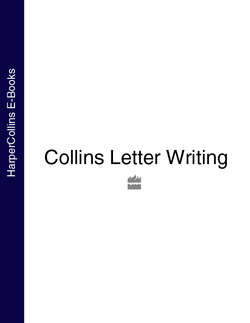Читать книгу Collins Letter Writing - Collins Dictionaries - Страница 21
EXERCISE
Оглавление1 Compare these typefaces.
2 Decide which one you like the best and consider why.
3 Consider which you find easiest to read.
4 Compare each text extract, which is the opening paragraph of a novel by Dickens, with its designated typeface and decide whether the two could be said to match in style.
5 Think briefly about your friends and decide which typeface you might use to write to each of them.
HELVETICA
My father’s family name being Pirrip, and my Christian name Philip, my infant tongue could make of both names nothing longer or more explicit than Pip. So I called myself Pip, and came to be called Pip.
Charles Dickens, ‘Great Expectations’ (1860)
This is a piece of prose supposedly describing someone’s childhood nickname. The written style is simple and the typeface is sans-serif and quite childlike in appearance. There is quite an appropriate match between style and content.
IMPACT
It was the best of times, it was the worst of times, it was the age of wisdom, it was the age of foolishness, it was the epoch of belief, it was the epoch of incredulity, it was the season of Light, it was the season of Darkness, it was the spring of hope, it was the winter of despair. Charles Dickens, A Tale of Two Cities (1859)
This is quite an epic opening to a novel. It is a declaration of a whole state of being and written in a distinctly Victorian style. The typeface looks quite modern, which is at odds with the period style of the writing, and lacks authority. The typeface is therefore at variance with the text both in feel and in appearance.
BRITANNIC BOLD
In these times of ours, though concerning the exact year there is no need to be precise, a boat of dirty and disreputable appearance, with two figures in it, floated on the Thames, between Southwark Bridge which is of iron, and London Bridge which is of stone, as an autumn evening closing in.
Charles Dickens, ‘Our Mutual Friend’ (1865)
This is a perfectly straightforward piece of descriptive prose with a touch of mystery to it. The typeface has certain old-fashioned characteristics – most notably on the ‘g’ – and, although it captures a little of the air of mystery about the piece, it’s not really clear enough to sustain a narrative of any length.
GOUDY TEXT
In the year 1775, there stood upon the borders of Epping Forest, at a distance of about twelve Miles from London – measuring from the Standard in Cornhill, or rather from the spot on or near to which the Standard used to be in days of yore – a house of public entertainment called the Maypole; which fact was demonstrated to all such travellers as could neither read nor write (and at that time a vast number both of travellers and stay-at-homes were in this condition) by the emblem reared on the roadside over against the house.
Charles Dickens, ‘Barnaby Rudge’ (1841)
This is an opening which immediately conjures up a picture of ‘days of yore’. Apart from the fact that the typeface is quite difficult to read, its high decorative values make it look quite antique. It is not a bad match, but not a perfect one either.
DOLMEN
As no lady or gentleman, with any claims to polite breeding, can possibly sympathise with the Chuzzlewit Family without being first assured of the extreme antiquity of the race, it is a great satisfaction to know that it undoubtedly descended in a direct line from Adam and Eve; and was, in the very earliest times, closely connected with the agricultural interest.
Charles Dickens, ‘Martin Chuzzlewit’ (1843)
The sentence is, again, quite a portentous one but in a rather more modest way. The author is clearly suggesting that the Chuzzlewits consider themselves to be a very distinguished family and he is slightly ridiculing them for this. The typeface is, for one thing, rather difficult to read. There is nothing in the text to suggest that this is an appropriate typeface.
There are no right answers: it is a question of personal taste, tact and common sense.
